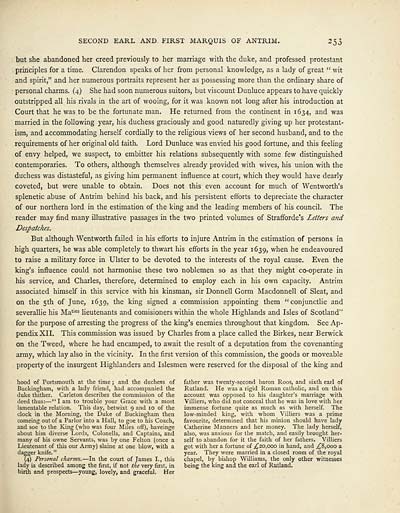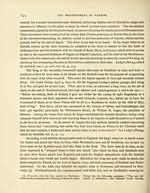Historical account of the Macdonnells of Antrim
(267) Page 253
Download files
Complete book:
Individual page:
Thumbnail gallery: Grid view | List view

SECOND EARL AND FIRST MARQUIS OF ANTRIM. 253
but she abandoned her creed previously to her marriage with the duke, and professed protestant
principles for a time. Clarendon speaks of her from personal knowledge, as a lady of great " wit
and spirit," and her numerous portraits represent her as possessing more than the ordinary share of
personal charms. (4) She had soon numerous suitors, but viscount Dunluce appears to have quickly
outstripped all his rivals in the art of wooing, for it was known not long after his introduction at
Court that he was to be the fortunate man. He returned from the continent in 1634, and was
married in the following year, his duchess graciously and good naturedly giving up her protestant-
ism, and accommodating herself cordially to the religious views of her second husband, and to the
requirements of her original old faith. Lord Dunluce was envied his good fortune, and this feeling
of envy helped, we suspect, to embitter his relations subsequently with some few distinguished
contemporaries. To others, although themselves already provided with wives, his union with the
duchess was distasteful, as giving him permanent influence at court, which they would have dearly
coveted, but were unable to obtain. Does not this even account for much of Wentworth's
splenetic abuse of Antrim behind his back, and his persistent efforts to depreciate the character
of our northern lord in the estimation of the king and the leading members of his council. The
reader may find many illustrative passages in the two printed volumes of Strafforde's Letters and
Despatches.
But although Wentvvorth failed in his efforts to injure Antrim in the estimation of persons in
high quarters, he was able completely to thwart his efforts in the year 1639, when he endeavoured
to raise a military force in Ulster to be devoted to the interests of the royal cause. Even the
king's influence could not harmonise these two noblemen so as that they might co-operate in
his service, and Charles, therefore, determined to employ each in his own capacity. Antrim
associated himself in this service with his kinsman, sir Donnell Gorm Macdonnell of Sleat, and
on the 5th of June, 1639, the king signed a commission appointing them "conjunctlie and
severallie his Ma ties lieutenants and comisioners within the whole Highlands and Isles of Scotland"
for the purpose of arresting the progress of the king's enemies throughout that kingdom. See Ap-
pendix XII. This commission was issued by Charles from a place called the Birkes, near Berwick
on the Tweed, where he had encamped, to await the result of a deputation from the covenanting
army, which lay also in the vicinity. In the first version of this commission, the goods or moveable
property of the insurgent Highlanders and Islesmen were reserved for the disposal of the king and
hood of Portsmouth at the time ; and the duchess of father was twenty-second baron Roos, and sixth earl of
Buckingham, with a lady friend, had accompanied the Rutland. He was a rigid Roman catholic, and on this
duke thither. Carleton describes the commission of the account was opposed to his daughter's marriage with
deed thus: — " I am to trouble your Grace with a most Villiers, who did not conceal that he was in love with her
lamentable relation. This day, betwixt 9 and 10 of the immense fortune quite as much as with herself. The
clock in the Morning, the Duke of Buckingham then low-minded king, with whom Villiers was a prime
comeing out of a Parlor into a Hall, to goe to his Coach, favourite, determined that his minion should have lady
and soe to the King (who was four Miles off), haveinge Catherine Manners and her money. The lady herself,
about him diverse Lords, Colonells, and Captains, and also, was anxious for the match, and easily brought her-
many of his owne Servants, was by one Felton (once a self to abandon for it the faith of her fathers. Villiers
Lieutenant of this our Army) slaine at one blow, with a got with her a fortune of ,£20,000 in hand, and £8,000 a
dagger knife. " year. They were married in a closed room of the royal
(4) Personal charms. — In the court of James I., this chapel, by bishop Williams, the only other witnesses
lady is described among the first, if not the very first, in being the king and the earl of Rutland,
birth and prospects — young, lovely, and graceful. Her
but she abandoned her creed previously to her marriage with the duke, and professed protestant
principles for a time. Clarendon speaks of her from personal knowledge, as a lady of great " wit
and spirit," and her numerous portraits represent her as possessing more than the ordinary share of
personal charms. (4) She had soon numerous suitors, but viscount Dunluce appears to have quickly
outstripped all his rivals in the art of wooing, for it was known not long after his introduction at
Court that he was to be the fortunate man. He returned from the continent in 1634, and was
married in the following year, his duchess graciously and good naturedly giving up her protestant-
ism, and accommodating herself cordially to the religious views of her second husband, and to the
requirements of her original old faith. Lord Dunluce was envied his good fortune, and this feeling
of envy helped, we suspect, to embitter his relations subsequently with some few distinguished
contemporaries. To others, although themselves already provided with wives, his union with the
duchess was distasteful, as giving him permanent influence at court, which they would have dearly
coveted, but were unable to obtain. Does not this even account for much of Wentworth's
splenetic abuse of Antrim behind his back, and his persistent efforts to depreciate the character
of our northern lord in the estimation of the king and the leading members of his council. The
reader may find many illustrative passages in the two printed volumes of Strafforde's Letters and
Despatches.
But although Wentvvorth failed in his efforts to injure Antrim in the estimation of persons in
high quarters, he was able completely to thwart his efforts in the year 1639, when he endeavoured
to raise a military force in Ulster to be devoted to the interests of the royal cause. Even the
king's influence could not harmonise these two noblemen so as that they might co-operate in
his service, and Charles, therefore, determined to employ each in his own capacity. Antrim
associated himself in this service with his kinsman, sir Donnell Gorm Macdonnell of Sleat, and
on the 5th of June, 1639, the king signed a commission appointing them "conjunctlie and
severallie his Ma ties lieutenants and comisioners within the whole Highlands and Isles of Scotland"
for the purpose of arresting the progress of the king's enemies throughout that kingdom. See Ap-
pendix XII. This commission was issued by Charles from a place called the Birkes, near Berwick
on the Tweed, where he had encamped, to await the result of a deputation from the covenanting
army, which lay also in the vicinity. In the first version of this commission, the goods or moveable
property of the insurgent Highlanders and Islesmen were reserved for the disposal of the king and
hood of Portsmouth at the time ; and the duchess of father was twenty-second baron Roos, and sixth earl of
Buckingham, with a lady friend, had accompanied the Rutland. He was a rigid Roman catholic, and on this
duke thither. Carleton describes the commission of the account was opposed to his daughter's marriage with
deed thus: — " I am to trouble your Grace with a most Villiers, who did not conceal that he was in love with her
lamentable relation. This day, betwixt 9 and 10 of the immense fortune quite as much as with herself. The
clock in the Morning, the Duke of Buckingham then low-minded king, with whom Villiers was a prime
comeing out of a Parlor into a Hall, to goe to his Coach, favourite, determined that his minion should have lady
and soe to the King (who was four Miles off), haveinge Catherine Manners and her money. The lady herself,
about him diverse Lords, Colonells, and Captains, and also, was anxious for the match, and easily brought her-
many of his owne Servants, was by one Felton (once a self to abandon for it the faith of her fathers. Villiers
Lieutenant of this our Army) slaine at one blow, with a got with her a fortune of ,£20,000 in hand, and £8,000 a
dagger knife. " year. They were married in a closed room of the royal
(4) Personal charms. — In the court of James I., this chapel, by bishop Williams, the only other witnesses
lady is described among the first, if not the very first, in being the king and the earl of Rutland,
birth and prospects — young, lovely, and graceful. Her
Set display mode to:
![]() Universal Viewer |
Universal Viewer | ![]() Mirador |
Large image | Transcription
Mirador |
Large image | Transcription
Images and transcriptions on this page, including medium image downloads, may be used under the Creative Commons Attribution 4.0 International Licence unless otherwise stated. ![]()
| Histories of Scottish families > Historical account of the Macdonnells of Antrim > (267) Page 253 |
|---|
| Permanent URL | https://digital.nls.uk/95344451 |
|---|
| Description | A selection of almost 400 printed items relating to the history of Scottish families, mostly dating from the 19th and early 20th centuries. Includes memoirs, genealogies and clan histories, with a few produced by emigrant families. The earliest family history goes back to AD 916. |
|---|

